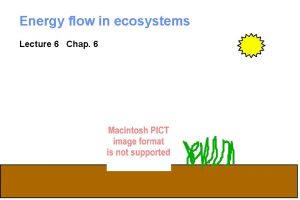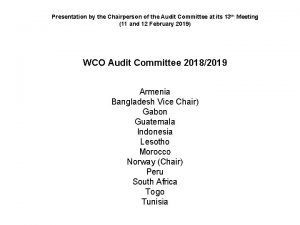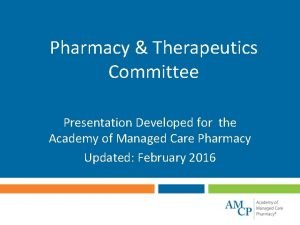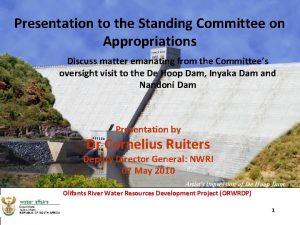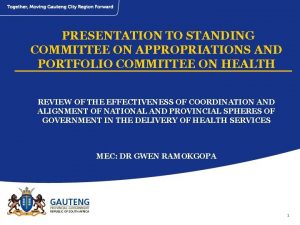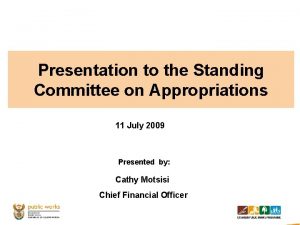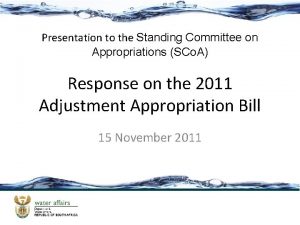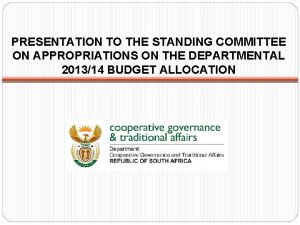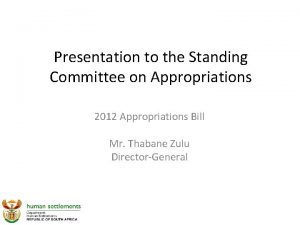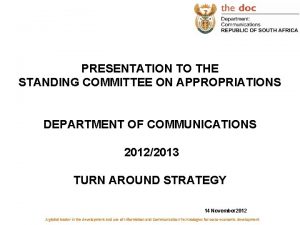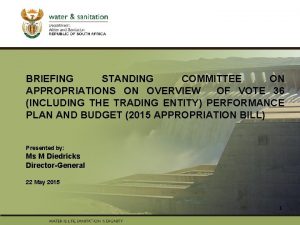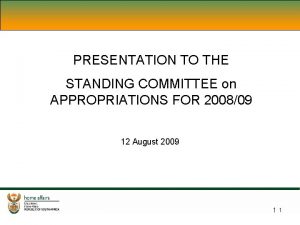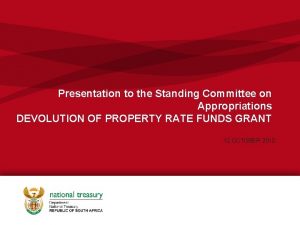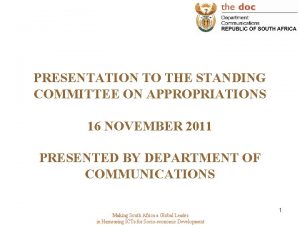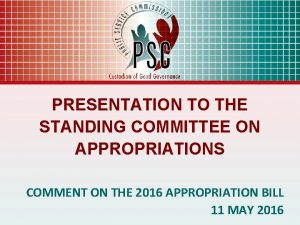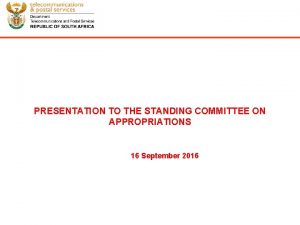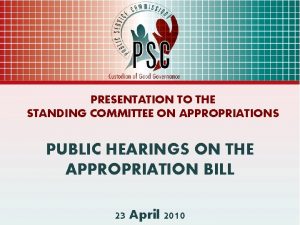HSRC Presentation to the Standing Committee on Appropriations




















- Slides: 20

HSRC Presentation to the Standing Committee on Appropriations: 23 April 2010

Government priorities • Create decent work and sustainable livelihoods • Rural development strategy linked to land agrarian reform and food security • Education • Health • Fight crime and corruption

Improve health care and health of the population

Ten point plan 1. Provide strategic leadership and creation of social compact for better health outcomes 2. Implement national health insurance plan 3. Improve quality of health services 4. Improve human resource management 5. Overhaul the health care system and improve its management 6. Revitalize of physical infrastructure 7. Accelerated implementation of HIV and AIDS plan and reduction of mortality due to TB and associated diseases 8. Mobilise masses for better health for the population 9. Review drug policy 10. Research and development

Health - HIV and AIDS • Our country now boasts the largest ARV treatment programme in the world with nearly 1 million people living with HIV and AIDS having been initiated on treatment to date. This is an enormous achievement albeit we also have the largest number of people living with HIV and AIDS in the world. • Unfortunately for every person initiating treatment, another four to six become newly infected. • Therefore, there is a growing consensus about the need to balance our emphasis on both ARV treatment and prevention. • The coordinating role of SANAC in our national response is therefore critical to ensure that our country can win the battle against HIV/AIDS.

Respondents aged 15 years and older who ever had an HIV test, South Africa, HSRC 2002, HSRC 2005 and HSRC 2008 2002 Yes % Male 21. 4 Female 21. 4 Total 21. 4 2005 Male 27. 6 Female 32. 9 Total 30. 5 2008 Male 43. 0 Female 56. 7 Total 50. 8

Reach of HIV/AIDS communication by age, South Africa, 2005 and 2008 Age 2005(%) 2008(%) Youth (15 -24 years) 86. 3 90. 2 Adults (25 -49 years) 77. 8 83. 6 Adults (≥ 50 years) 47. 2 62. 2 Total 74. 0 80. 9

Prevalence of self-reported male circumcision: South Africa 2002. (Source: Connolly, Simbayi, Shanmugam & Nqeketo, 2008 SAMJ)

HIV and AIDS - Policy implications • The new treatment criteria and the current HCT campaign will lead to an enormous increase in the number of people requiring ARV treatment. • There will also be a great need to promote prevention activities among those who are HIVnegative. • The government has decided to implement medical male circumcision as an HIV prevention strategy as part of a male sexual and reproductive health package. There is also a need to create some synergy between traditional and medical male circumcision.

HIV and AIDS - Policy implications (contd) • Three provinces, namely, Kwa. Zulu-Natal (KZN), Mpumalanga and Northern Cape have been prioritized by the national Do. H to start implementing medical male circumcision from this year. • KZN has developed a full plan to implement over the next 5 years and started to implement it at two pilot sites following the proclamation by His Majesty King Goodwill Zwelethini to remove the cultural ban on male circumcision which has lasted over 200 years among the Zulus. • Clearly, there is a need to find some local funding to implement their excellent plan together with donor funding to ensure sustainability of the provincial as well as national goals to circumcise more men than is the case hitherto.

Appropriations for HIV and AIDS (contd) • Increased allocations to the Comprehensive HIV and AIDS Grant and increased support for large NGOs in the HIV and AIDS sector dealing with Behavioural change communication (BCC) such as love. Life and Soul City as well as allocations for improving both human resources and quality of health services in the Health budget are welcomed. • With the proposed sourcing of cheaper ARVs it is hoped that the allocation will not prevent any stock outs as witnessed in some provinces last year but also ensure that many more people needing them will access them. • However, there is also a need for some additional resources to promote other new prevention strategies such as medical male circumcision especially in the three priority provinces of KZN, MP and NC.

Appropriations for HIV and AIDS (contd) • It is interesting to note that love. Life is also allocated some additional funding through Social Development. This is indeed most welcome as it is an important organization in the fight against HIV and AIDS especially among the youth in our country. • Social Development is also responsible for social grant payments and the appropriations show that the bulk of this allocation is being passed on to recipients. This is indeed most appropriate as it also helps to deal with the problem of orphaned and vulnerable children, most of them who are made vulnerable to HIV infections by both HIV and AIDS and poverty.

Appropriations for HIV prevention (contd) • The allocation to Science & Technology for HIV and AIDS prevention and treatment technologies research should be revisited. • More support from this department and indeed Health itself is required for research into social/structural (including social norms) and behavioural HIV prevention interventions as researchers currently mainly rely on funding from foreign governments and international institutions in the west.

Appropriations for HIV prevention (contd) • Finally, Basic Education has also been allocated an adequate HIV and AIDS (Life Skills Education) Grant to support its important work in trying to prevent our children from becoming infected with HIV and AIDS in the first place.

Rural Development

Rural development • • HSRC’s research investigates approaches to improving food security and expanding livelihoods especially through small scale agriculture. Small % of rural population economically active, and especially not in agriculture • More than 40% of population live in rural areas, but less than 10% of economically active are engaged in agriculture • Typically closer to 80% of the rural adult population involved in agriculture. Even in developed countries can be approximately 25% • Economic participation is generally very low, especially in former bantustans

Rural development • Policy implications: • Growing spending on rural development from R 6. 7 bn to R 8. 3 bn by 2012/3. This is large increase but still very small relative to the challenge and levels of neglect. • Agricultural support budgets allocated to provinces are also very small. In 2008/9, average agricultural expenditure per landed household was R 3, 700. • Critical attention is required to: • • Improve water management, water reticulation, water retention schemes • Land management and care, and environmental services • Agricultural support and extension to both commercial and household production • Research and development for both commercial farming and household production • Expanded processing nearer to agricultural producers where economically justified • Attention to inputs costs, such as fertiliser and equipment • More forceful export market development • Meaningful expansion of agricultural training colleges • Investment in agro-industrial logistics platform – such as rural roads and ability to export time-sensitive products Very weak monitoring and evaluation of small holder farming.

Rural Development and Land Reform • A conceptual and strategic framework for a Comprehensive Rural Development Program (CRDP) drafted • The strategy has outlined and clarified the following issues: • The Mandate for Rural Development and Land Reform • 3 pronged strategy for CRDP which includes • Agrarian Transformation; Rural Development & Land Reform • Fast-track expansion of ‘rural development pilot sites or nodes’

Rural Development and Land Reform • • Policy & capacity issues which include: • The development of a White Paper on Agrarian Transformation, Rural Development & Land Reform The Green Paper is to be tabled in cabinet shortly • Rural Development Agency (RDA) to co-ordinate implementation • Overhaul land policy framework & consolidate all land-related laws • A revised tenure security law for farm workers The controversy around the role of traditional leadership in land reform and development is not adequately addressed. Fix collapsing land reform projects through the land reform recap intervention- combined with CASP critical to sustain rural livelihoods

Thank you !!
 Difference between standing crop and standing state
Difference between standing crop and standing state Audit committee presentation
Audit committee presentation Loan committee presentation
Loan committee presentation Finance committee presentation
Finance committee presentation P&t committee presentation
P&t committee presentation Cách giải mật thư tọa độ
Cách giải mật thư tọa độ Tư thế ngồi viết
Tư thế ngồi viết Thế nào là giọng cùng tên? *
Thế nào là giọng cùng tên? * Gấu đi như thế nào
Gấu đi như thế nào Thẻ vin
Thẻ vin Thể thơ truyền thống
Thể thơ truyền thống Hổ đẻ mỗi lứa mấy con
Hổ đẻ mỗi lứa mấy con Từ ngữ thể hiện lòng nhân hậu
Từ ngữ thể hiện lòng nhân hậu Thế nào là hệ số cao nhất
Thế nào là hệ số cao nhất Diễn thế sinh thái là
Diễn thế sinh thái là Vẽ hình chiếu vuông góc của vật thể sau
Vẽ hình chiếu vuông góc của vật thể sau Phép trừ bù
Phép trừ bù Lời thề hippocrates
Lời thề hippocrates Vẽ hình chiếu đứng bằng cạnh của vật thể
Vẽ hình chiếu đứng bằng cạnh của vật thể Chụp tư thế worms-breton
Chụp tư thế worms-breton
